Non-Communicable Diseases (NCDs) Assignment
VerifiedAdded on 2021/06/15
|10
|3171
|113
AI Summary
Contribute Materials
Your contribution can guide someone’s learning journey. Share your
documents today.

[Date]
Global Challenge non-communicable disease
‘Evolution of the global non-communicable disease epidemic’.
Student details
email Id:
Global Challenge non-communicable disease
‘Evolution of the global non-communicable disease epidemic’.
Student details
email Id:
Secure Best Marks with AI Grader
Need help grading? Try our AI Grader for instant feedback on your assignments.
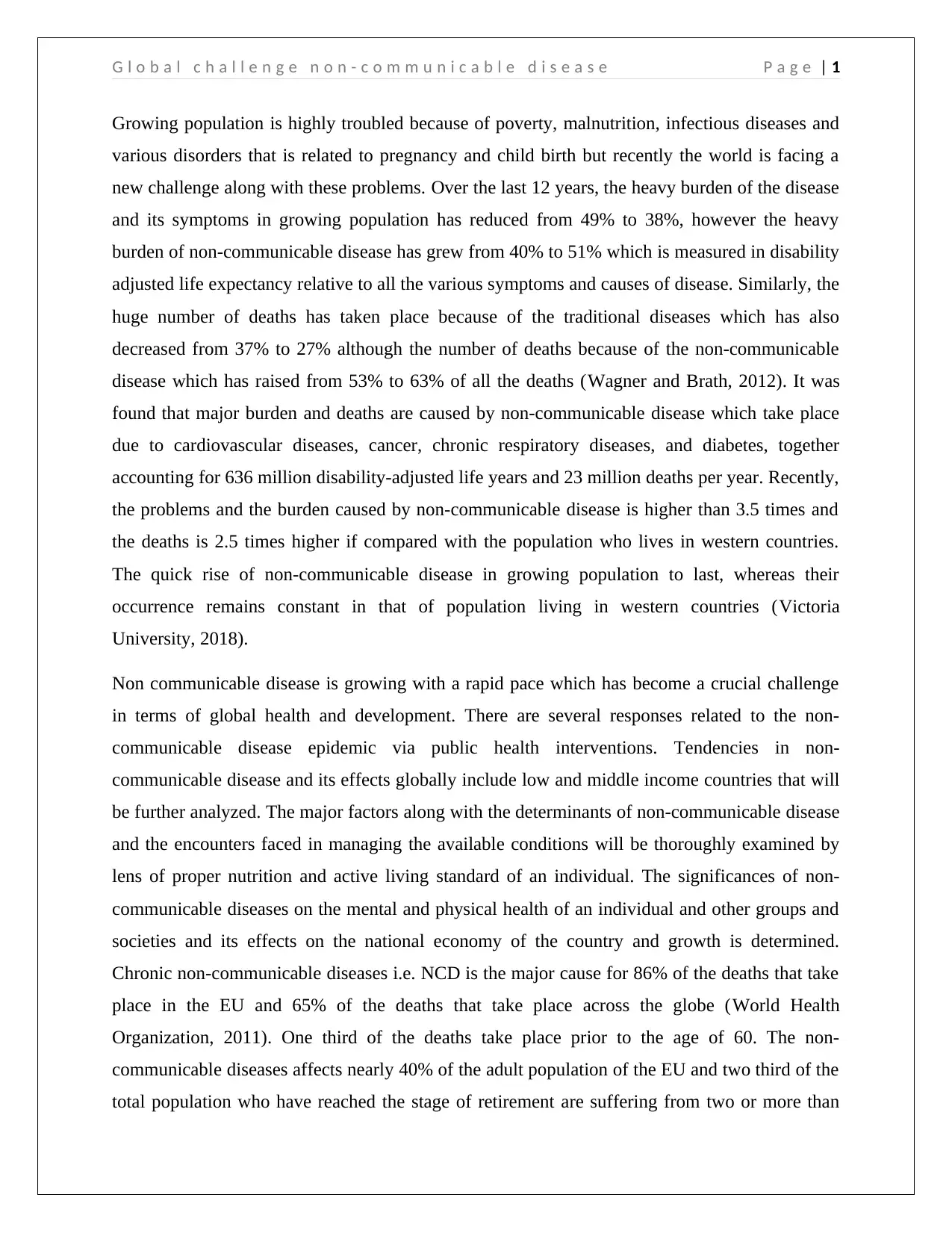
G l o b a l c h a l l e n g e n o n - c o m m u n i c a b l e d i s e a s e P a g e | 1
Growing population is highly troubled because of poverty, malnutrition, infectious diseases and
various disorders that is related to pregnancy and child birth but recently the world is facing a
new challenge along with these problems. Over the last 12 years, the heavy burden of the disease
and its symptoms in growing population has reduced from 49% to 38%, however the heavy
burden of non-communicable disease has grew from 40% to 51% which is measured in disability
adjusted life expectancy relative to all the various symptoms and causes of disease. Similarly, the
huge number of deaths has taken place because of the traditional diseases which has also
decreased from 37% to 27% although the number of deaths because of the non-communicable
disease which has raised from 53% to 63% of all the deaths (Wagner and Brath, 2012). It was
found that major burden and deaths are caused by non-communicable disease which take place
due to cardiovascular diseases, cancer, chronic respiratory diseases, and diabetes, together
accounting for 636 million disability-adjusted life years and 23 million deaths per year. Recently,
the problems and the burden caused by non-communicable disease is higher than 3.5 times and
the deaths is 2.5 times higher if compared with the population who lives in western countries.
The quick rise of non-communicable disease in growing population to last, whereas their
occurrence remains constant in that of population living in western countries (Victoria
University, 2018).
Non communicable disease is growing with a rapid pace which has become a crucial challenge
in terms of global health and development. There are several responses related to the non-
communicable disease epidemic via public health interventions. Tendencies in non-
communicable disease and its effects globally include low and middle income countries that will
be further analyzed. The major factors along with the determinants of non-communicable disease
and the encounters faced in managing the available conditions will be thoroughly examined by
lens of proper nutrition and active living standard of an individual. The significances of non-
communicable diseases on the mental and physical health of an individual and other groups and
societies and its effects on the national economy of the country and growth is determined.
Chronic non-communicable diseases i.e. NCD is the major cause for 86% of the deaths that take
place in the EU and 65% of the deaths that take place across the globe (World Health
Organization, 2011). One third of the deaths take place prior to the age of 60. The non-
communicable diseases affects nearly 40% of the adult population of the EU and two third of the
total population who have reached the stage of retirement are suffering from two or more than
Growing population is highly troubled because of poverty, malnutrition, infectious diseases and
various disorders that is related to pregnancy and child birth but recently the world is facing a
new challenge along with these problems. Over the last 12 years, the heavy burden of the disease
and its symptoms in growing population has reduced from 49% to 38%, however the heavy
burden of non-communicable disease has grew from 40% to 51% which is measured in disability
adjusted life expectancy relative to all the various symptoms and causes of disease. Similarly, the
huge number of deaths has taken place because of the traditional diseases which has also
decreased from 37% to 27% although the number of deaths because of the non-communicable
disease which has raised from 53% to 63% of all the deaths (Wagner and Brath, 2012). It was
found that major burden and deaths are caused by non-communicable disease which take place
due to cardiovascular diseases, cancer, chronic respiratory diseases, and diabetes, together
accounting for 636 million disability-adjusted life years and 23 million deaths per year. Recently,
the problems and the burden caused by non-communicable disease is higher than 3.5 times and
the deaths is 2.5 times higher if compared with the population who lives in western countries.
The quick rise of non-communicable disease in growing population to last, whereas their
occurrence remains constant in that of population living in western countries (Victoria
University, 2018).
Non communicable disease is growing with a rapid pace which has become a crucial challenge
in terms of global health and development. There are several responses related to the non-
communicable disease epidemic via public health interventions. Tendencies in non-
communicable disease and its effects globally include low and middle income countries that will
be further analyzed. The major factors along with the determinants of non-communicable disease
and the encounters faced in managing the available conditions will be thoroughly examined by
lens of proper nutrition and active living standard of an individual. The significances of non-
communicable diseases on the mental and physical health of an individual and other groups and
societies and its effects on the national economy of the country and growth is determined.
Chronic non-communicable diseases i.e. NCD is the major cause for 86% of the deaths that take
place in the EU and 65% of the deaths that take place across the globe (World Health
Organization, 2011). One third of the deaths take place prior to the age of 60. The non-
communicable diseases affects nearly 40% of the adult population of the EU and two third of the
total population who have reached the stage of retirement are suffering from two or more than
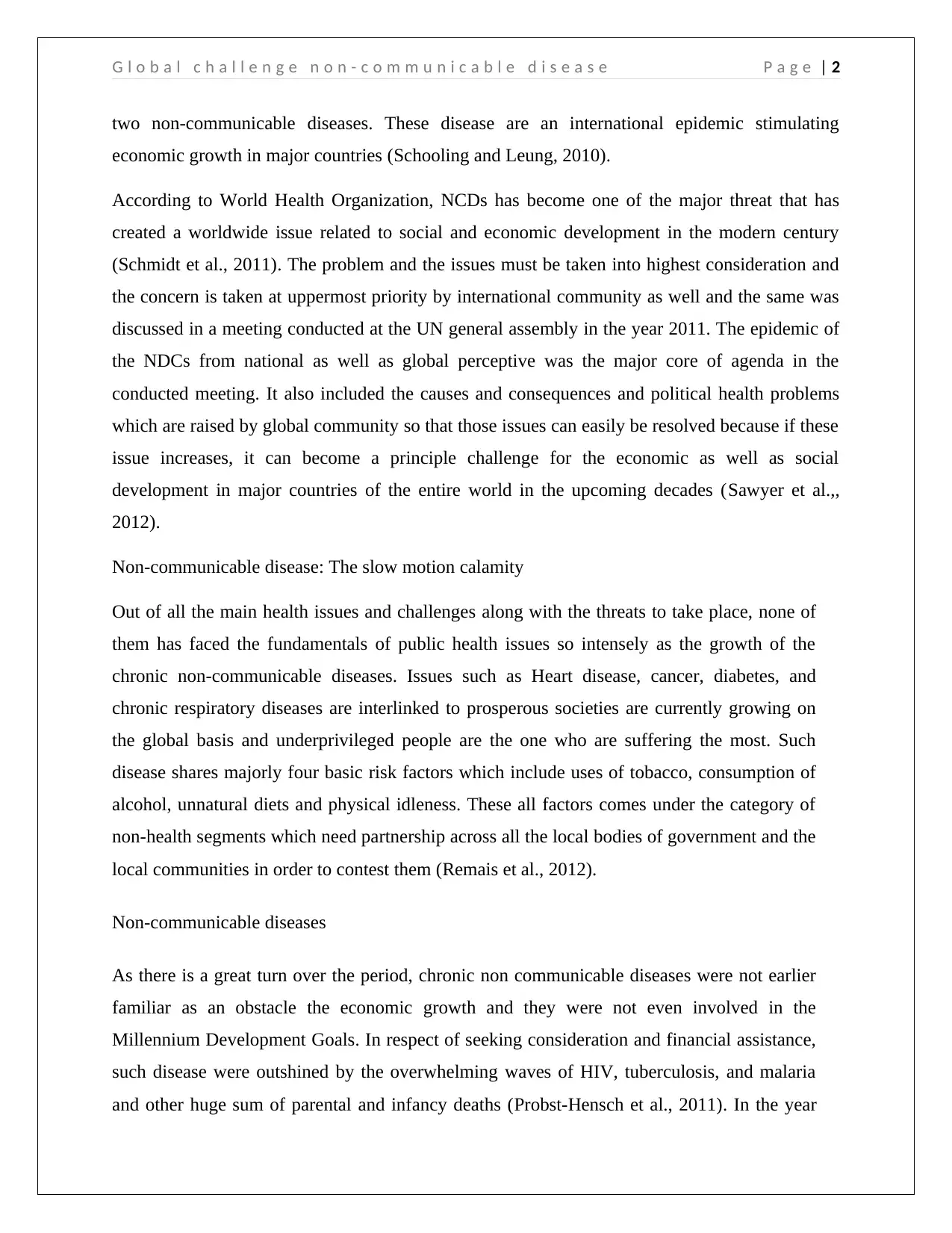
G l o b a l c h a l l e n g e n o n - c o m m u n i c a b l e d i s e a s e P a g e | 2
two non-communicable diseases. These disease are an international epidemic stimulating
economic growth in major countries (Schooling and Leung, 2010).
According to World Health Organization, NCDs has become one of the major threat that has
created a worldwide issue related to social and economic development in the modern century
(Schmidt et al., 2011). The problem and the issues must be taken into highest consideration and
the concern is taken at uppermost priority by international community as well and the same was
discussed in a meeting conducted at the UN general assembly in the year 2011. The epidemic of
the NDCs from national as well as global perceptive was the major core of agenda in the
conducted meeting. It also included the causes and consequences and political health problems
which are raised by global community so that those issues can easily be resolved because if these
issue increases, it can become a principle challenge for the economic as well as social
development in major countries of the entire world in the upcoming decades (Sawyer et al.,,
2012).
Non-communicable disease: The slow motion calamity
Out of all the main health issues and challenges along with the threats to take place, none of
them has faced the fundamentals of public health issues so intensely as the growth of the
chronic non-communicable diseases. Issues such as Heart disease, cancer, diabetes, and
chronic respiratory diseases are interlinked to prosperous societies are currently growing on
the global basis and underprivileged people are the one who are suffering the most. Such
disease shares majorly four basic risk factors which include uses of tobacco, consumption of
alcohol, unnatural diets and physical idleness. These all factors comes under the category of
non-health segments which need partnership across all the local bodies of government and the
local communities in order to contest them (Remais et al., 2012).
Non-communicable diseases
As there is a great turn over the period, chronic non communicable diseases were not earlier
familiar as an obstacle the economic growth and they were not even involved in the
Millennium Development Goals. In respect of seeking consideration and financial assistance,
such disease were outshined by the overwhelming waves of HIV, tuberculosis, and malaria
and other huge sum of parental and infancy deaths (Probst-Hensch et al., 2011). In the year
two non-communicable diseases. These disease are an international epidemic stimulating
economic growth in major countries (Schooling and Leung, 2010).
According to World Health Organization, NCDs has become one of the major threat that has
created a worldwide issue related to social and economic development in the modern century
(Schmidt et al., 2011). The problem and the issues must be taken into highest consideration and
the concern is taken at uppermost priority by international community as well and the same was
discussed in a meeting conducted at the UN general assembly in the year 2011. The epidemic of
the NDCs from national as well as global perceptive was the major core of agenda in the
conducted meeting. It also included the causes and consequences and political health problems
which are raised by global community so that those issues can easily be resolved because if these
issue increases, it can become a principle challenge for the economic as well as social
development in major countries of the entire world in the upcoming decades (Sawyer et al.,,
2012).
Non-communicable disease: The slow motion calamity
Out of all the main health issues and challenges along with the threats to take place, none of
them has faced the fundamentals of public health issues so intensely as the growth of the
chronic non-communicable diseases. Issues such as Heart disease, cancer, diabetes, and
chronic respiratory diseases are interlinked to prosperous societies are currently growing on
the global basis and underprivileged people are the one who are suffering the most. Such
disease shares majorly four basic risk factors which include uses of tobacco, consumption of
alcohol, unnatural diets and physical idleness. These all factors comes under the category of
non-health segments which need partnership across all the local bodies of government and the
local communities in order to contest them (Remais et al., 2012).
Non-communicable diseases
As there is a great turn over the period, chronic non communicable diseases were not earlier
familiar as an obstacle the economic growth and they were not even involved in the
Millennium Development Goals. In respect of seeking consideration and financial assistance,
such disease were outshined by the overwhelming waves of HIV, tuberculosis, and malaria
and other huge sum of parental and infancy deaths (Probst-Hensch et al., 2011). In the year
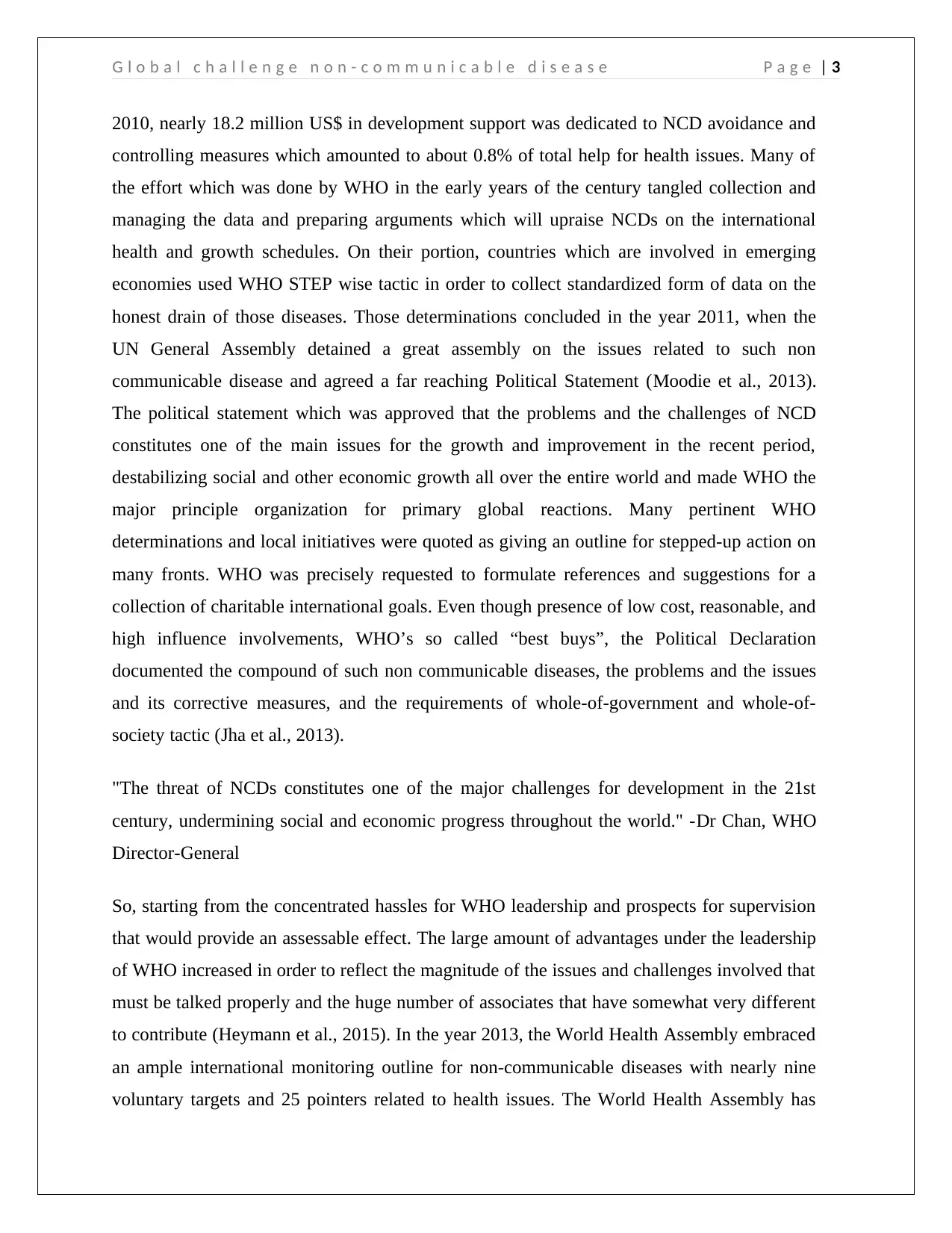
G l o b a l c h a l l e n g e n o n - c o m m u n i c a b l e d i s e a s e P a g e | 3
2010, nearly 18.2 million US$ in development support was dedicated to NCD avoidance and
controlling measures which amounted to about 0.8% of total help for health issues. Many of
the effort which was done by WHO in the early years of the century tangled collection and
managing the data and preparing arguments which will upraise NCDs on the international
health and growth schedules. On their portion, countries which are involved in emerging
economies used WHO STEP wise tactic in order to collect standardized form of data on the
honest drain of those diseases. Those determinations concluded in the year 2011, when the
UN General Assembly detained a great assembly on the issues related to such non
communicable disease and agreed a far reaching Political Statement (Moodie et al., 2013).
The political statement which was approved that the problems and the challenges of NCD
constitutes one of the main issues for the growth and improvement in the recent period,
destabilizing social and other economic growth all over the entire world and made WHO the
major principle organization for primary global reactions. Many pertinent WHO
determinations and local initiatives were quoted as giving an outline for stepped-up action on
many fronts. WHO was precisely requested to formulate references and suggestions for a
collection of charitable international goals. Even though presence of low cost, reasonable, and
high influence involvements, WHO’s so called “best buys”, the Political Declaration
documented the compound of such non communicable diseases, the problems and the issues
and its corrective measures, and the requirements of whole-of-government and whole-of-
society tactic (Jha et al., 2013).
"The threat of NCDs constitutes one of the major challenges for development in the 21st
century, undermining social and economic progress throughout the world." -Dr Chan, WHO
Director-General
So, starting from the concentrated hassles for WHO leadership and prospects for supervision
that would provide an assessable effect. The large amount of advantages under the leadership
of WHO increased in order to reflect the magnitude of the issues and challenges involved that
must be talked properly and the huge number of associates that have somewhat very different
to contribute (Heymann et al., 2015). In the year 2013, the World Health Assembly embraced
an ample international monitoring outline for non-communicable diseases with nearly nine
voluntary targets and 25 pointers related to health issues. The World Health Assembly has
2010, nearly 18.2 million US$ in development support was dedicated to NCD avoidance and
controlling measures which amounted to about 0.8% of total help for health issues. Many of
the effort which was done by WHO in the early years of the century tangled collection and
managing the data and preparing arguments which will upraise NCDs on the international
health and growth schedules. On their portion, countries which are involved in emerging
economies used WHO STEP wise tactic in order to collect standardized form of data on the
honest drain of those diseases. Those determinations concluded in the year 2011, when the
UN General Assembly detained a great assembly on the issues related to such non
communicable disease and agreed a far reaching Political Statement (Moodie et al., 2013).
The political statement which was approved that the problems and the challenges of NCD
constitutes one of the main issues for the growth and improvement in the recent period,
destabilizing social and other economic growth all over the entire world and made WHO the
major principle organization for primary global reactions. Many pertinent WHO
determinations and local initiatives were quoted as giving an outline for stepped-up action on
many fronts. WHO was precisely requested to formulate references and suggestions for a
collection of charitable international goals. Even though presence of low cost, reasonable, and
high influence involvements, WHO’s so called “best buys”, the Political Declaration
documented the compound of such non communicable diseases, the problems and the issues
and its corrective measures, and the requirements of whole-of-government and whole-of-
society tactic (Jha et al., 2013).
"The threat of NCDs constitutes one of the major challenges for development in the 21st
century, undermining social and economic progress throughout the world." -Dr Chan, WHO
Director-General
So, starting from the concentrated hassles for WHO leadership and prospects for supervision
that would provide an assessable effect. The large amount of advantages under the leadership
of WHO increased in order to reflect the magnitude of the issues and challenges involved that
must be talked properly and the huge number of associates that have somewhat very different
to contribute (Heymann et al., 2015). In the year 2013, the World Health Assembly embraced
an ample international monitoring outline for non-communicable diseases with nearly nine
voluntary targets and 25 pointers related to health issues. The World Health Assembly has
Secure Best Marks with AI Grader
Need help grading? Try our AI Grader for instant feedback on your assignments.
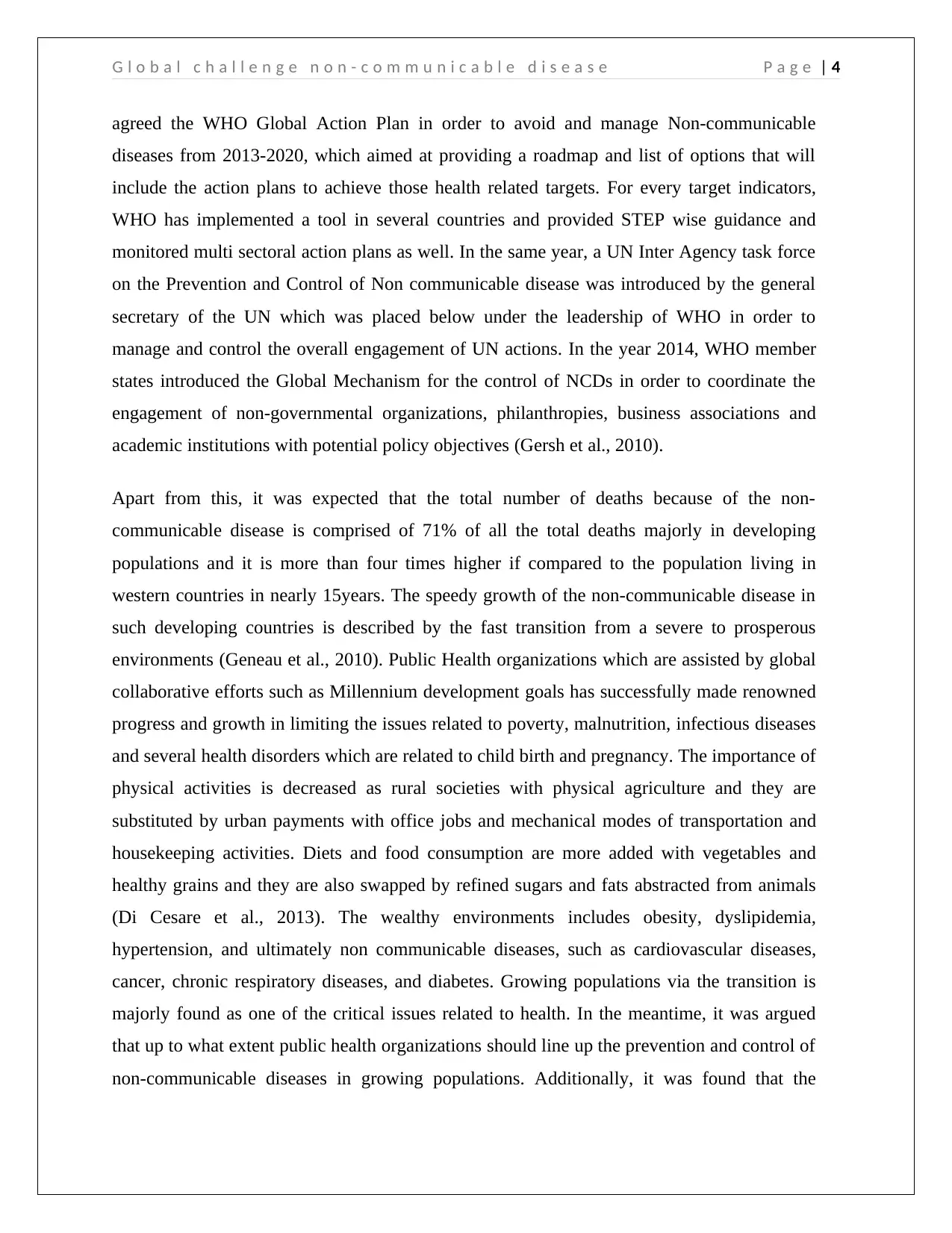
G l o b a l c h a l l e n g e n o n - c o m m u n i c a b l e d i s e a s e P a g e | 4
agreed the WHO Global Action Plan in order to avoid and manage Non-communicable
diseases from 2013-2020, which aimed at providing a roadmap and list of options that will
include the action plans to achieve those health related targets. For every target indicators,
WHO has implemented a tool in several countries and provided STEP wise guidance and
monitored multi sectoral action plans as well. In the same year, a UN Inter Agency task force
on the Prevention and Control of Non communicable disease was introduced by the general
secretary of the UN which was placed below under the leadership of WHO in order to
manage and control the overall engagement of UN actions. In the year 2014, WHO member
states introduced the Global Mechanism for the control of NCDs in order to coordinate the
engagement of non-governmental organizations, philanthropies, business associations and
academic institutions with potential policy objectives (Gersh et al., 2010).
Apart from this, it was expected that the total number of deaths because of the non-
communicable disease is comprised of 71% of all the total deaths majorly in developing
populations and it is more than four times higher if compared to the population living in
western countries in nearly 15years. The speedy growth of the non-communicable disease in
such developing countries is described by the fast transition from a severe to prosperous
environments (Geneau et al., 2010). Public Health organizations which are assisted by global
collaborative efforts such as Millennium development goals has successfully made renowned
progress and growth in limiting the issues related to poverty, malnutrition, infectious diseases
and several health disorders which are related to child birth and pregnancy. The importance of
physical activities is decreased as rural societies with physical agriculture and they are
substituted by urban payments with office jobs and mechanical modes of transportation and
housekeeping activities. Diets and food consumption are more added with vegetables and
healthy grains and they are also swapped by refined sugars and fats abstracted from animals
(Di Cesare et al., 2013). The wealthy environments includes obesity, dyslipidemia,
hypertension, and ultimately non communicable diseases, such as cardiovascular diseases,
cancer, chronic respiratory diseases, and diabetes. Growing populations via the transition is
majorly found as one of the critical issues related to health. In the meantime, it was argued
that up to what extent public health organizations should line up the prevention and control of
non-communicable diseases in growing populations. Additionally, it was found that the
agreed the WHO Global Action Plan in order to avoid and manage Non-communicable
diseases from 2013-2020, which aimed at providing a roadmap and list of options that will
include the action plans to achieve those health related targets. For every target indicators,
WHO has implemented a tool in several countries and provided STEP wise guidance and
monitored multi sectoral action plans as well. In the same year, a UN Inter Agency task force
on the Prevention and Control of Non communicable disease was introduced by the general
secretary of the UN which was placed below under the leadership of WHO in order to
manage and control the overall engagement of UN actions. In the year 2014, WHO member
states introduced the Global Mechanism for the control of NCDs in order to coordinate the
engagement of non-governmental organizations, philanthropies, business associations and
academic institutions with potential policy objectives (Gersh et al., 2010).
Apart from this, it was expected that the total number of deaths because of the non-
communicable disease is comprised of 71% of all the total deaths majorly in developing
populations and it is more than four times higher if compared to the population living in
western countries in nearly 15years. The speedy growth of the non-communicable disease in
such developing countries is described by the fast transition from a severe to prosperous
environments (Geneau et al., 2010). Public Health organizations which are assisted by global
collaborative efforts such as Millennium development goals has successfully made renowned
progress and growth in limiting the issues related to poverty, malnutrition, infectious diseases
and several health disorders which are related to child birth and pregnancy. The importance of
physical activities is decreased as rural societies with physical agriculture and they are
substituted by urban payments with office jobs and mechanical modes of transportation and
housekeeping activities. Diets and food consumption are more added with vegetables and
healthy grains and they are also swapped by refined sugars and fats abstracted from animals
(Di Cesare et al., 2013). The wealthy environments includes obesity, dyslipidemia,
hypertension, and ultimately non communicable diseases, such as cardiovascular diseases,
cancer, chronic respiratory diseases, and diabetes. Growing populations via the transition is
majorly found as one of the critical issues related to health. In the meantime, it was argued
that up to what extent public health organizations should line up the prevention and control of
non-communicable diseases in growing populations. Additionally, it was found that the
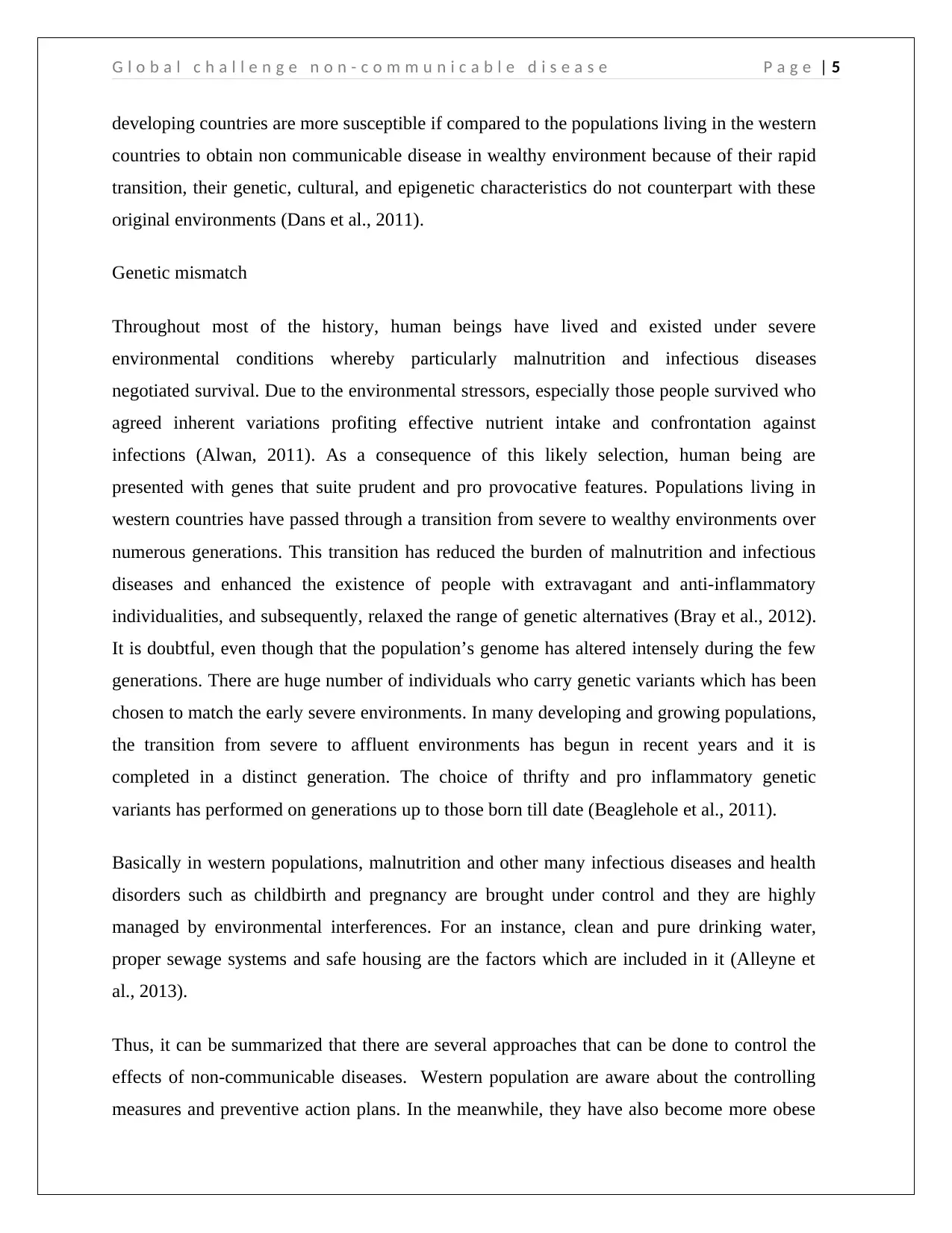
G l o b a l c h a l l e n g e n o n - c o m m u n i c a b l e d i s e a s e P a g e | 5
developing countries are more susceptible if compared to the populations living in the western
countries to obtain non communicable disease in wealthy environment because of their rapid
transition, their genetic, cultural, and epigenetic characteristics do not counterpart with these
original environments (Dans et al., 2011).
Genetic mismatch
Throughout most of the history, human beings have lived and existed under severe
environmental conditions whereby particularly malnutrition and infectious diseases
negotiated survival. Due to the environmental stressors, especially those people survived who
agreed inherent variations profiting effective nutrient intake and confrontation against
infections (Alwan, 2011). As a consequence of this likely selection, human being are
presented with genes that suite prudent and pro provocative features. Populations living in
western countries have passed through a transition from severe to wealthy environments over
numerous generations. This transition has reduced the burden of malnutrition and infectious
diseases and enhanced the existence of people with extravagant and anti-inflammatory
individualities, and subsequently, relaxed the range of genetic alternatives (Bray et al., 2012).
It is doubtful, even though that the population’s genome has altered intensely during the few
generations. There are huge number of individuals who carry genetic variants which has been
chosen to match the early severe environments. In many developing and growing populations,
the transition from severe to affluent environments has begun in recent years and it is
completed in a distinct generation. The choice of thrifty and pro inflammatory genetic
variants has performed on generations up to those born till date (Beaglehole et al., 2011).
Basically in western populations, malnutrition and other many infectious diseases and health
disorders such as childbirth and pregnancy are brought under control and they are highly
managed by environmental interferences. For an instance, clean and pure drinking water,
proper sewage systems and safe housing are the factors which are included in it (Alleyne et
al., 2013).
Thus, it can be summarized that there are several approaches that can be done to control the
effects of non-communicable diseases. Western population are aware about the controlling
measures and preventive action plans. In the meanwhile, they have also become more obese
developing countries are more susceptible if compared to the populations living in the western
countries to obtain non communicable disease in wealthy environment because of their rapid
transition, their genetic, cultural, and epigenetic characteristics do not counterpart with these
original environments (Dans et al., 2011).
Genetic mismatch
Throughout most of the history, human beings have lived and existed under severe
environmental conditions whereby particularly malnutrition and infectious diseases
negotiated survival. Due to the environmental stressors, especially those people survived who
agreed inherent variations profiting effective nutrient intake and confrontation against
infections (Alwan, 2011). As a consequence of this likely selection, human being are
presented with genes that suite prudent and pro provocative features. Populations living in
western countries have passed through a transition from severe to wealthy environments over
numerous generations. This transition has reduced the burden of malnutrition and infectious
diseases and enhanced the existence of people with extravagant and anti-inflammatory
individualities, and subsequently, relaxed the range of genetic alternatives (Bray et al., 2012).
It is doubtful, even though that the population’s genome has altered intensely during the few
generations. There are huge number of individuals who carry genetic variants which has been
chosen to match the early severe environments. In many developing and growing populations,
the transition from severe to affluent environments has begun in recent years and it is
completed in a distinct generation. The choice of thrifty and pro inflammatory genetic
variants has performed on generations up to those born till date (Beaglehole et al., 2011).
Basically in western populations, malnutrition and other many infectious diseases and health
disorders such as childbirth and pregnancy are brought under control and they are highly
managed by environmental interferences. For an instance, clean and pure drinking water,
proper sewage systems and safe housing are the factors which are included in it (Alleyne et
al., 2013).
Thus, it can be summarized that there are several approaches that can be done to control the
effects of non-communicable diseases. Western population are aware about the controlling
measures and preventive action plans. In the meanwhile, they have also become more obese

G l o b a l c h a l l e n g e n o n - c o m m u n i c a b l e d i s e a s e P a g e | 6
and sedentary. The prevention of non-communicable diseases is instead followed by healthier
treatment majorly for the cardiovascular disease.
and sedentary. The prevention of non-communicable diseases is instead followed by healthier
treatment majorly for the cardiovascular disease.
Paraphrase This Document
Need a fresh take? Get an instant paraphrase of this document with our AI Paraphraser
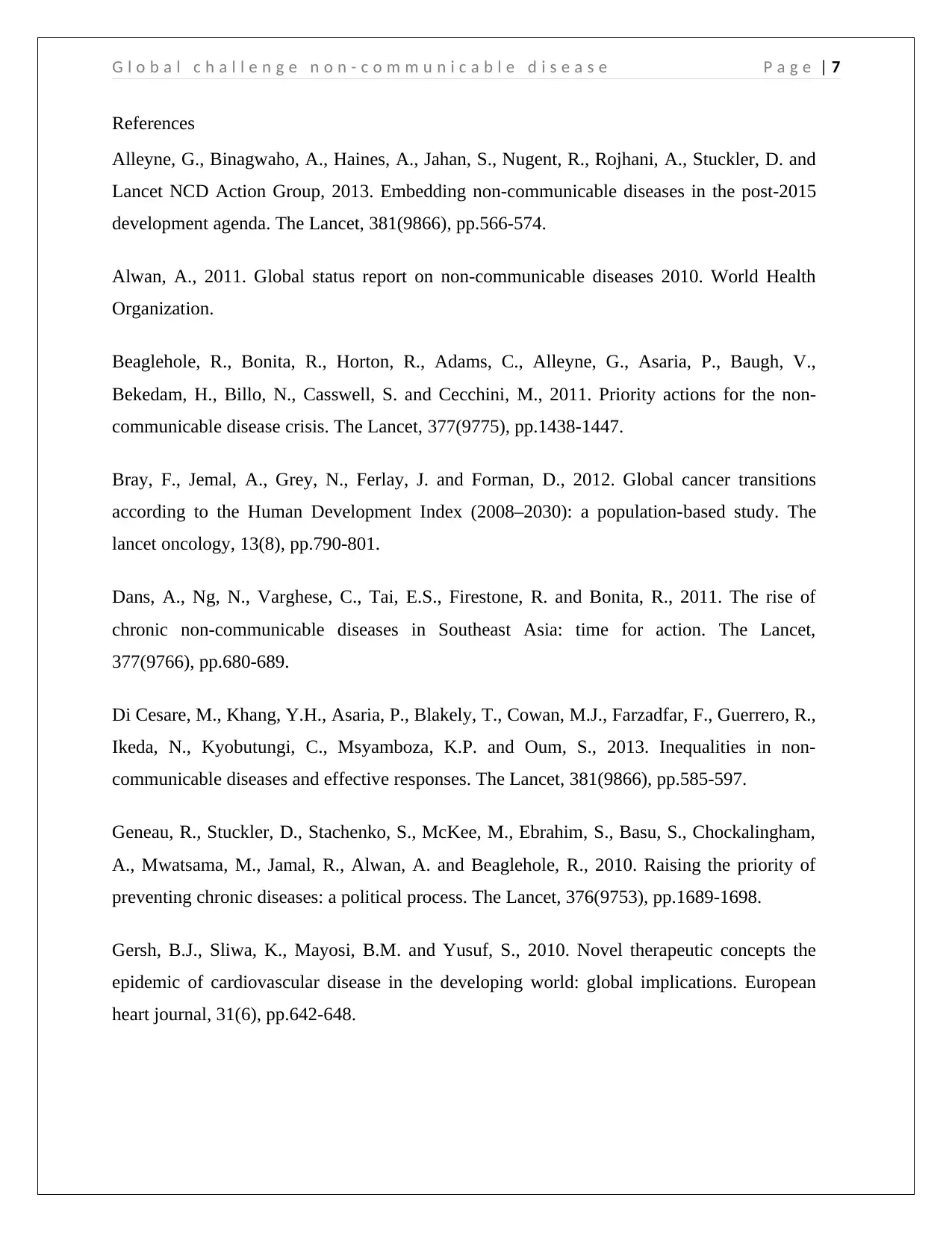
G l o b a l c h a l l e n g e n o n - c o m m u n i c a b l e d i s e a s e P a g e | 7
References
Alleyne, G., Binagwaho, A., Haines, A., Jahan, S., Nugent, R., Rojhani, A., Stuckler, D. and
Lancet NCD Action Group, 2013. Embedding non-communicable diseases in the post-2015
development agenda. The Lancet, 381(9866), pp.566-574.
Alwan, A., 2011. Global status report on non-communicable diseases 2010. World Health
Organization.
Beaglehole, R., Bonita, R., Horton, R., Adams, C., Alleyne, G., Asaria, P., Baugh, V.,
Bekedam, H., Billo, N., Casswell, S. and Cecchini, M., 2011. Priority actions for the non-
communicable disease crisis. The Lancet, 377(9775), pp.1438-1447.
Bray, F., Jemal, A., Grey, N., Ferlay, J. and Forman, D., 2012. Global cancer transitions
according to the Human Development Index (2008–2030): a population-based study. The
lancet oncology, 13(8), pp.790-801.
Dans, A., Ng, N., Varghese, C., Tai, E.S., Firestone, R. and Bonita, R., 2011. The rise of
chronic non-communicable diseases in Southeast Asia: time for action. The Lancet,
377(9766), pp.680-689.
Di Cesare, M., Khang, Y.H., Asaria, P., Blakely, T., Cowan, M.J., Farzadfar, F., Guerrero, R.,
Ikeda, N., Kyobutungi, C., Msyamboza, K.P. and Oum, S., 2013. Inequalities in non-
communicable diseases and effective responses. The Lancet, 381(9866), pp.585-597.
Geneau, R., Stuckler, D., Stachenko, S., McKee, M., Ebrahim, S., Basu, S., Chockalingham,
A., Mwatsama, M., Jamal, R., Alwan, A. and Beaglehole, R., 2010. Raising the priority of
preventing chronic diseases: a political process. The Lancet, 376(9753), pp.1689-1698.
Gersh, B.J., Sliwa, K., Mayosi, B.M. and Yusuf, S., 2010. Novel therapeutic concepts the
epidemic of cardiovascular disease in the developing world: global implications. European
heart journal, 31(6), pp.642-648.
References
Alleyne, G., Binagwaho, A., Haines, A., Jahan, S., Nugent, R., Rojhani, A., Stuckler, D. and
Lancet NCD Action Group, 2013. Embedding non-communicable diseases in the post-2015
development agenda. The Lancet, 381(9866), pp.566-574.
Alwan, A., 2011. Global status report on non-communicable diseases 2010. World Health
Organization.
Beaglehole, R., Bonita, R., Horton, R., Adams, C., Alleyne, G., Asaria, P., Baugh, V.,
Bekedam, H., Billo, N., Casswell, S. and Cecchini, M., 2011. Priority actions for the non-
communicable disease crisis. The Lancet, 377(9775), pp.1438-1447.
Bray, F., Jemal, A., Grey, N., Ferlay, J. and Forman, D., 2012. Global cancer transitions
according to the Human Development Index (2008–2030): a population-based study. The
lancet oncology, 13(8), pp.790-801.
Dans, A., Ng, N., Varghese, C., Tai, E.S., Firestone, R. and Bonita, R., 2011. The rise of
chronic non-communicable diseases in Southeast Asia: time for action. The Lancet,
377(9766), pp.680-689.
Di Cesare, M., Khang, Y.H., Asaria, P., Blakely, T., Cowan, M.J., Farzadfar, F., Guerrero, R.,
Ikeda, N., Kyobutungi, C., Msyamboza, K.P. and Oum, S., 2013. Inequalities in non-
communicable diseases and effective responses. The Lancet, 381(9866), pp.585-597.
Geneau, R., Stuckler, D., Stachenko, S., McKee, M., Ebrahim, S., Basu, S., Chockalingham,
A., Mwatsama, M., Jamal, R., Alwan, A. and Beaglehole, R., 2010. Raising the priority of
preventing chronic diseases: a political process. The Lancet, 376(9753), pp.1689-1698.
Gersh, B.J., Sliwa, K., Mayosi, B.M. and Yusuf, S., 2010. Novel therapeutic concepts the
epidemic of cardiovascular disease in the developing world: global implications. European
heart journal, 31(6), pp.642-648.
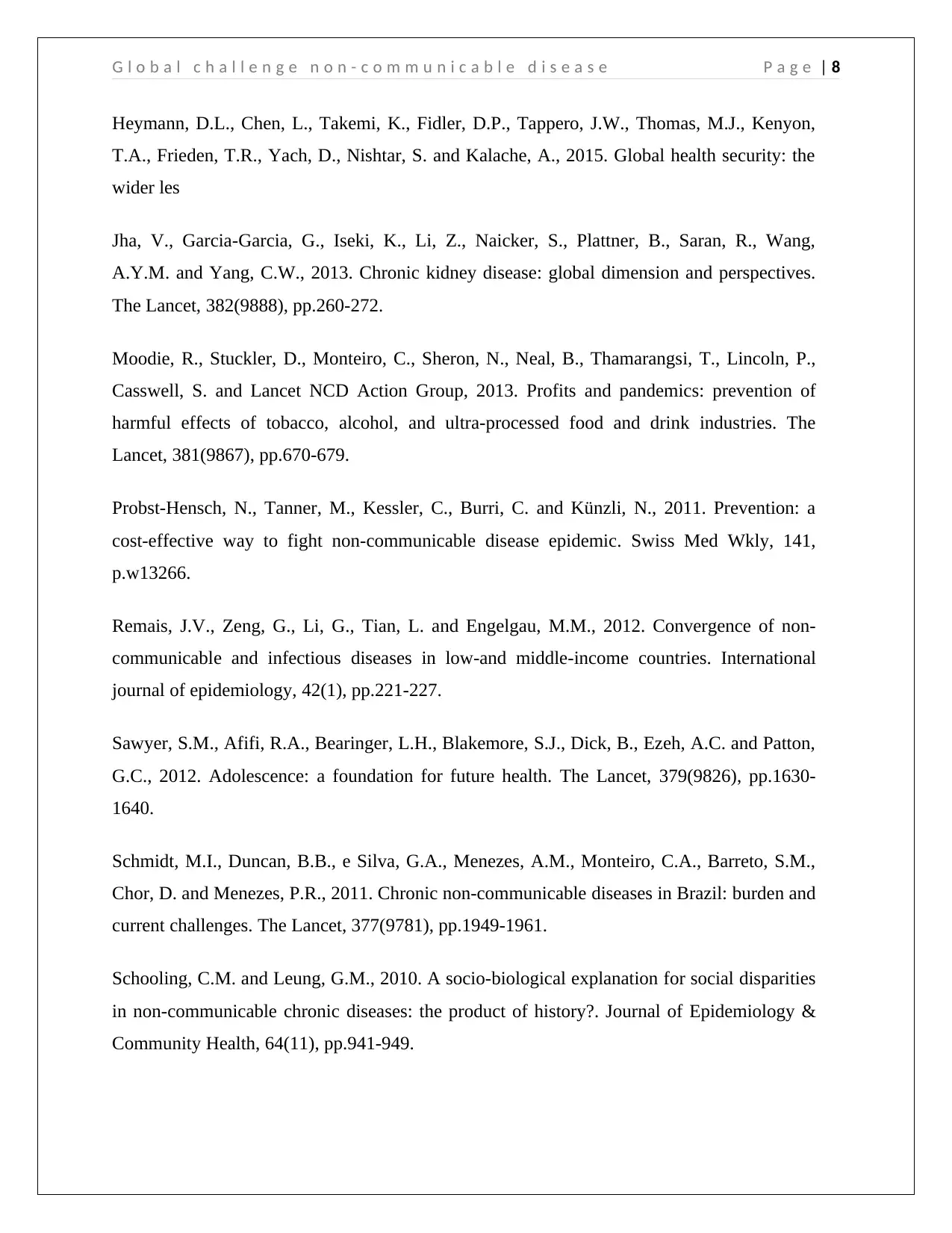
G l o b a l c h a l l e n g e n o n - c o m m u n i c a b l e d i s e a s e P a g e | 8
Heymann, D.L., Chen, L., Takemi, K., Fidler, D.P., Tappero, J.W., Thomas, M.J., Kenyon,
T.A., Frieden, T.R., Yach, D., Nishtar, S. and Kalache, A., 2015. Global health security: the
wider les
Jha, V., Garcia-Garcia, G., Iseki, K., Li, Z., Naicker, S., Plattner, B., Saran, R., Wang,
A.Y.M. and Yang, C.W., 2013. Chronic kidney disease: global dimension and perspectives.
The Lancet, 382(9888), pp.260-272.
Moodie, R., Stuckler, D., Monteiro, C., Sheron, N., Neal, B., Thamarangsi, T., Lincoln, P.,
Casswell, S. and Lancet NCD Action Group, 2013. Profits and pandemics: prevention of
harmful effects of tobacco, alcohol, and ultra-processed food and drink industries. The
Lancet, 381(9867), pp.670-679.
Probst-Hensch, N., Tanner, M., Kessler, C., Burri, C. and Künzli, N., 2011. Prevention: a
cost-effective way to fight non-communicable disease epidemic. Swiss Med Wkly, 141,
p.w13266.
Remais, J.V., Zeng, G., Li, G., Tian, L. and Engelgau, M.M., 2012. Convergence of non-
communicable and infectious diseases in low-and middle-income countries. International
journal of epidemiology, 42(1), pp.221-227.
Sawyer, S.M., Afifi, R.A., Bearinger, L.H., Blakemore, S.J., Dick, B., Ezeh, A.C. and Patton,
G.C., 2012. Adolescence: a foundation for future health. The Lancet, 379(9826), pp.1630-
1640.
Schmidt, M.I., Duncan, B.B., e Silva, G.A., Menezes, A.M., Monteiro, C.A., Barreto, S.M.,
Chor, D. and Menezes, P.R., 2011. Chronic non-communicable diseases in Brazil: burden and
current challenges. The Lancet, 377(9781), pp.1949-1961.
Schooling, C.M. and Leung, G.M., 2010. A socio-biological explanation for social disparities
in non-communicable chronic diseases: the product of history?. Journal of Epidemiology &
Community Health, 64(11), pp.941-949.
Heymann, D.L., Chen, L., Takemi, K., Fidler, D.P., Tappero, J.W., Thomas, M.J., Kenyon,
T.A., Frieden, T.R., Yach, D., Nishtar, S. and Kalache, A., 2015. Global health security: the
wider les
Jha, V., Garcia-Garcia, G., Iseki, K., Li, Z., Naicker, S., Plattner, B., Saran, R., Wang,
A.Y.M. and Yang, C.W., 2013. Chronic kidney disease: global dimension and perspectives.
The Lancet, 382(9888), pp.260-272.
Moodie, R., Stuckler, D., Monteiro, C., Sheron, N., Neal, B., Thamarangsi, T., Lincoln, P.,
Casswell, S. and Lancet NCD Action Group, 2013. Profits and pandemics: prevention of
harmful effects of tobacco, alcohol, and ultra-processed food and drink industries. The
Lancet, 381(9867), pp.670-679.
Probst-Hensch, N., Tanner, M., Kessler, C., Burri, C. and Künzli, N., 2011. Prevention: a
cost-effective way to fight non-communicable disease epidemic. Swiss Med Wkly, 141,
p.w13266.
Remais, J.V., Zeng, G., Li, G., Tian, L. and Engelgau, M.M., 2012. Convergence of non-
communicable and infectious diseases in low-and middle-income countries. International
journal of epidemiology, 42(1), pp.221-227.
Sawyer, S.M., Afifi, R.A., Bearinger, L.H., Blakemore, S.J., Dick, B., Ezeh, A.C. and Patton,
G.C., 2012. Adolescence: a foundation for future health. The Lancet, 379(9826), pp.1630-
1640.
Schmidt, M.I., Duncan, B.B., e Silva, G.A., Menezes, A.M., Monteiro, C.A., Barreto, S.M.,
Chor, D. and Menezes, P.R., 2011. Chronic non-communicable diseases in Brazil: burden and
current challenges. The Lancet, 377(9781), pp.1949-1961.
Schooling, C.M. and Leung, G.M., 2010. A socio-biological explanation for social disparities
in non-communicable chronic diseases: the product of history?. Journal of Epidemiology &
Community Health, 64(11), pp.941-949.
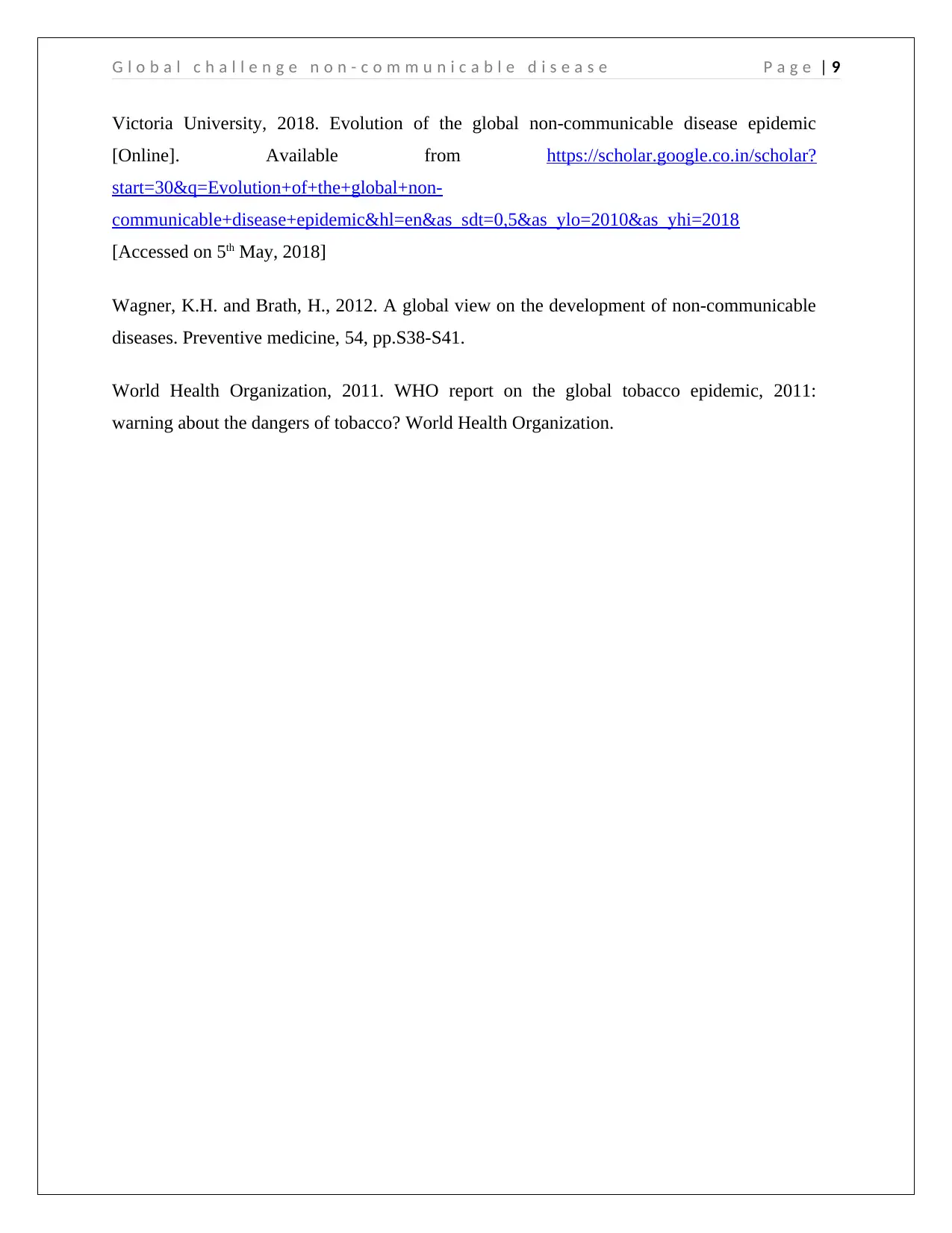
G l o b a l c h a l l e n g e n o n - c o m m u n i c a b l e d i s e a s e P a g e | 9
Victoria University, 2018. Evolution of the global non-communicable disease epidemic
[Online]. Available from https://scholar.google.co.in/scholar?
start=30&q=Evolution+of+the+global+non-
communicable+disease+epidemic&hl=en&as_sdt=0,5&as_ylo=2010&as_yhi=2018
[Accessed on 5th May, 2018]
Wagner, K.H. and Brath, H., 2012. A global view on the development of non-communicable
diseases. Preventive medicine, 54, pp.S38-S41.
World Health Organization, 2011. WHO report on the global tobacco epidemic, 2011:
warning about the dangers of tobacco? World Health Organization.
Victoria University, 2018. Evolution of the global non-communicable disease epidemic
[Online]. Available from https://scholar.google.co.in/scholar?
start=30&q=Evolution+of+the+global+non-
communicable+disease+epidemic&hl=en&as_sdt=0,5&as_ylo=2010&as_yhi=2018
[Accessed on 5th May, 2018]
Wagner, K.H. and Brath, H., 2012. A global view on the development of non-communicable
diseases. Preventive medicine, 54, pp.S38-S41.
World Health Organization, 2011. WHO report on the global tobacco epidemic, 2011:
warning about the dangers of tobacco? World Health Organization.
1 out of 10
Related Documents
Your All-in-One AI-Powered Toolkit for Academic Success.
+13062052269
info@desklib.com
Available 24*7 on WhatsApp / Email
![[object Object]](/_next/static/media/star-bottom.7253800d.svg)
Unlock your academic potential
© 2024 | Zucol Services PVT LTD | All rights reserved.





